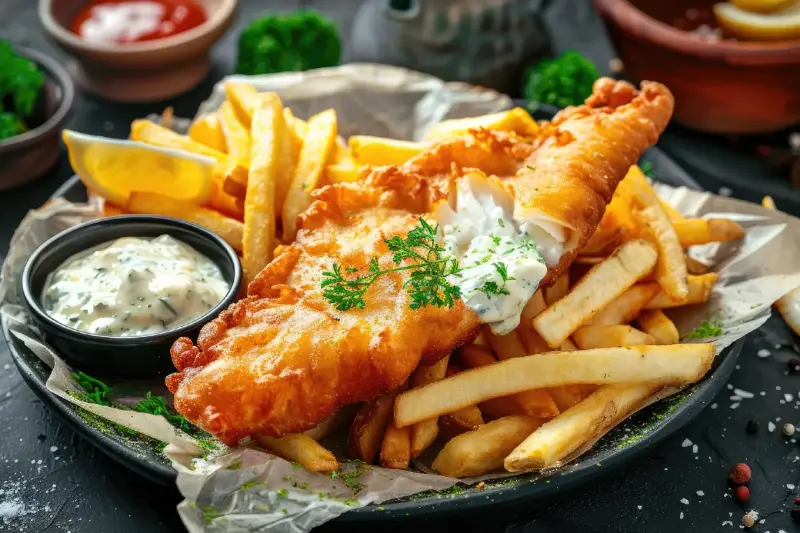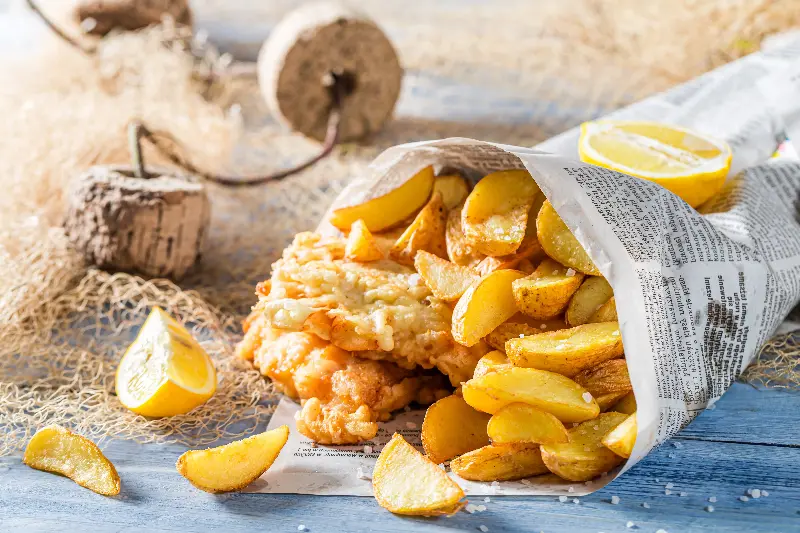Few dishes evoke the same sense of nostalgia, comfort, and cross-cultural admiration as fish and chips. While often seen as quintessentially British, this classic meal has transcended its island origins to become a beloved dish across the globe. But how did this unassuming pairing of fried fish and golden potatoes become an international culinary icon? The answer lies in a tapestry woven from history, ingenuity, and the enduring power of simple pleasures.

Humble Roots: The Origins of Fish and Chips
The story of fish and chips is, fittingly, a tale of two halves united by circumstance. Fried fish, inspired by Sephardic Jewish immigrants’ traditions, found its way to British shores in the 17th century. These new arrivals to England introduced Pescado frito—white fish coated in flour and fried in oil—to the British palate. On the other side of this duo, chips, or “French fries,” had made their debut in continental Europe before being enjoyed across England by the early 19th century.
The genius of fish and chips was simply putting the two together. This marriage is credited to Joseph Malin, who opened what is widely regarded as the world’s first fish and chip shop in East London in 1860. Other contenders for the title exist—northern towns stake their claim—but Malin’s shop is generally accepted as the birthplace of the classic takeaway. Cheap, filling, and tasty, fish and chips quickly became a staple for Britain’s working class, sold from makeshift stands and wrapped in yesterday’s newspaper.
Fish, Chips, and Wartime Britain
By the late 19th and early 20th century, fish and chips shops, known locally as “chippies,” dotted high streets up and down the United Kingdom. Their popularity reached new heights during the First and Second World Wars. As rationing tightened belts and limited options, fish and chips gained status as an unofficial national treasure. Famously, the British government never rationed the components of this dish, ensuring it remained accessible to all. At the height of its popularity in the 1920s and 30s, Britain boasted more than 35,000 fish and chip shops—one on virtually every street corner in some towns.
It is said Winston Churchill described fish and chips as “the good companions.” Their role as morale boosters during tough times cannot be overstated. In a landscape shaped by air raids and blackouts, a hot bag of fish and chips brought comfort and normalcy, giving the entire nation something to savour together.

A Dish That Crossed Oceans
The tale of fish and chips did not end on Britain’s shores. Wherever British settlers or travellers journeyed, the dish followed. In Australia and New Zealand, it became a beloved part of coastal culture; in South Africa and Canada, local ingredients put unique spins on the original. Today, you’ll find fish and chip stalls in the most unlikely places, from bustling Asian night markets to Caribbean beachfronts.
Even the choice of fish varies by region. Cod and haddock remain favourites in the UK, but barramundi appears in Australia, hoki in New Zealand, and tilapia in the Caribbean. British-style chippies thrive in Canada, alongside local takes involving poutine. In South Africa, “slap chips,” thicker and softer than their British cousins, steal the show.
What unites all these versions is the core appeal: a crispy, flakey piece of fried fish paired with hot, salted chips. Often served with malt vinegar, mushy peas, or tartare sauce, this combination strikes a perfect balance between rich, crispy, and satisfying.
The Science and Ritual of The Perfect Chippy
Behind the irresistible aroma and crunch lies a tried-and-true method perfected over generations. The secret is in the batter—often a combination of flour, water, and sometimes beer—which puffs and crisps up in response to a very hot oil bath. Potatoes are thick-cut, soaked to remove excess starch, and double-cooked: a blanching fry followed by a high-temperature finish for maximum crunch.
For many, the ritual is as delightful as the meal itself. Whether you recall queueing up outside a seaside chippy, balancing a newspaper cone on your knee, or dousing your fries with vinegar, these sensory details are embedded in the collective memory. Some shops still wrap orders in paper, echoing the days when recycled newspapers carried your steaming feast—a nod to thrift and tradition.

Iconic Status in Modern Food Culture
Today, fish and chips continue to win new fans, adapting to changing tastes and dietary values. Sustainable sourcing has become a priority, with many chippies choosing line-caught or responsibly farmed fish. Innovative twists emerge regularly, from gluten-free and vegan versions to gourmet interpretations that honour the dish’s roots while embracing contemporary palates.
The appeal of fish and chips goes beyond simple sustenance. It is food as history, as ritual, as shared experience. Whether eaten on a windswept pier or at a late-night counter, this meal reminds us that even the humblest ingredients can capture our hearts—and create unforgettable moments.
At its core, the tale of fish and chips is a celebration of resilience, resourcefulness, and the joy found in good company over a simple, well-made dish. It’s no wonder this classic continues to be cherished, not just in Britain, but around the world.
